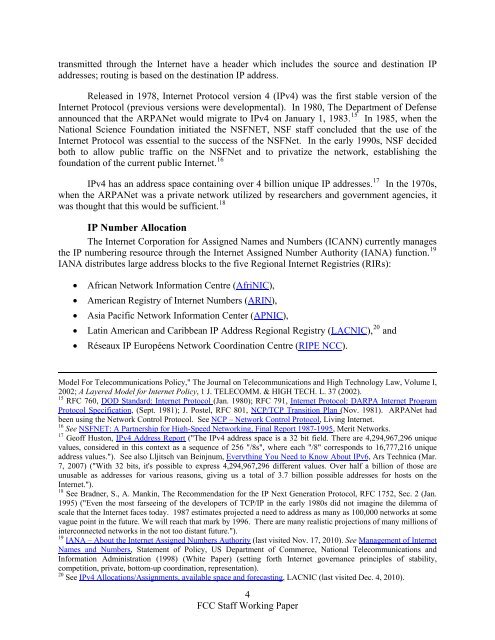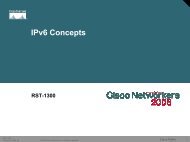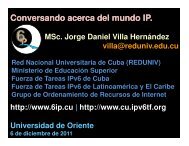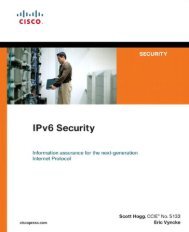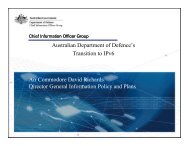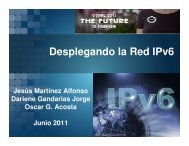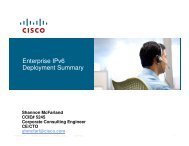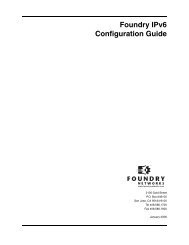IPv4 Exhaustion, IPv6 Transition, - Saudi Arabia IPv6 Task Force
IPv4 Exhaustion, IPv6 Transition, - Saudi Arabia IPv6 Task Force
IPv4 Exhaustion, IPv6 Transition, - Saudi Arabia IPv6 Task Force
Create successful ePaper yourself
Turn your PDF publications into a flip-book with our unique Google optimized e-Paper software.
transmitted through the Internet have a header which includes the source and destination IPaddresses; routing is based on the destination IP address.Released in 1978, Internet Protocol version 4 (<strong>IPv4</strong>) was the first stable version of theInternet Protocol (previous versions were developmental). In 1980, The Department of Defenseannounced that the ARPANet would migrate to <strong>IPv4</strong> on January 1, 1983. 15 In 1985, when theNational Science Foundation initiated the NSFNET, NSF staff concluded that the use of theInternet Protocol was essential to the success of the NSFNet. In the early 1990s, NSF decidedboth to allow public traffic on the NSFNet and to privatize the network, establishing thefoundation of the current public Internet. 16<strong>IPv4</strong> has an address space containing over 4 billion unique IP addresses. 17 In the 1970s,when the ARPANet was a private network utilized by researchers and government agencies, itwas thought that this would be sufficient. 18IP Number AllocationThe Internet Corporation for Assigned Names and Numbers (ICANN) currently managesthe IP numbering resource through the Internet Assigned Number Authority (IANA) function. 19IANA distributes large address blocks to the five Regional Internet Registries (RIRs):• African Network Information Centre (AfriNIC),• American Registry of Internet Numbers (ARIN),• Asia Pacific Network Information Center (APNIC),• Latin American and Caribbean IP Address Regional Registry (LACNIC), 20 and• Réseaux IP Européens Network Coordination Centre (RIPE NCC).Model For Telecommunications Policy," The Journal on Telecommunications and High Technology Law, Volume I,2002; A Layered Model for Internet Policy, 1 J. TELECOMM. & HIGH TECH. L. 37 (2002).15 RFC 760, DOD Standard: Internet Protocol (Jan. 1980); RFC 791, Internet Protocol: DARPA Internet ProgramProtocol Specification, (Sept. 1981); J. Postel, RFC 801, NCP/TCP <strong>Transition</strong> Plan (Nov. 1981). ARPANet hadbeen using the Network Control Protocol. See NCP – Network Control Protocol, Living Internet.16 See NSFNET: A Partnership for High-Speed Networking, Final Report 1987-1995, Merit Networks.17 Geoff Huston, <strong>IPv4</strong> Address Report ("The <strong>IPv4</strong> address space is a 32 bit field. There are 4,294,967,296 uniquevalues, considered in this context as a sequence of 256 "/8s", where each "/8" corresponds to 16,777,216 uniqueaddress values."). See also Lljitsch van Beinjnum, Everything You Need to Know About <strong>IPv6</strong>, Ars Technica (Mar.7, 2007) ("With 32 bits, it's possible to express 4,294,967,296 different values. Over half a billion of those areunusable as addresses for various reasons, giving us a total of 3.7 billion possible addresses for hosts on theInternet.").18 See Bradner, S., A. Mankin, The Recommendation for the IP Next Generation Protocol, RFC 1752, Sec. 2 (Jan.1995) ("Even the most farseeing of the developers of TCP/IP in the early 1980s did not imagine the dilemma ofscale that the Internet faces today. 1987 estimates projected a need to address as many as 100,000 networks at somevague point in the future. We will reach that mark by 1996. There are many realistic projections of many millions ofinterconnected networks in the not too distant future.").19 IANA – About the Internet Assigned Numbers Authority (last visited Nov. 17, 2010). See Management of InternetNames and Numbers, Statement of Policy, US Department of Commerce, National Telecommunications andInformation Administration (1998) (White Paper) (setting forth Internet governance principles of stability,competition, private, bottom-up coordination, representation).20 See <strong>IPv4</strong> Allocations/Assignments, available space and forecasting, LACNIC (last visited Dec. 4, 2010).4FCC Staff Working Paper


